Soil Quality Assessment Based on a Minimum Data Set: A Case Study of a County in the Typical River Delta Wetlands
Abstract
1. Introduction
2. Materials and Methods
2.1. Study Area
2.2. Data Collection
2.2.1. Soil Sample Analysis
2.2.2. The Auxiliary Data
2.3. Methods of Soil Quality Assessment
2.3.1. Determine the MDS
2.3.2. Weight Allocation
2.3.3. Indicator Scoring
2.3.4. SQI Calculation Method
2.4. Statistical Analysis
3. Results
3.1. The Characteristics and Spatial Variation Description of Soil in the Kenli District
3.2. MDS Selection and SQI Calculation
3.2.1. MDS Selection
3.2.2. Calculation of the SQI
3.3. Soil Quality Assessment in the Kenli District
3.3.1. The SQIs of Different Land Use Types
3.3.2. Spatial Distribution Characteristics of Soil Quality
3.4. Analysis of External Environmental Influencing Factors of SQI
4. Discussion
4.1. Scientific Evaluation and Explanation of the MDS
4.2. Rationality of the Soil Quality Evaluation in the Study Area
4.3. Recommendations for Soil Management in the Yellow River Delta
5. Conclusions
- (1)
- The average SQI of Kenli is 0.52, which is grade IV soil, and significant differences in the SQIs are noted among different land use types. The soil quality of agricultural land is greater than that of the natural land type as well as the bare land type. There is a certain law of the spatial distribution of soil SQI in the Kenli District, which mainly demonstrates that the closer the location is to the Yellow River, the better the soil quality will be. The soil quality of the eastern township is relatively greater than that of the western townships.
- (2)
- The analysis of the contribution of the MDS indicator to the SQI of each land type and township demonstrates that Na nitrogen and OM are the main indicators of limiting SQI in natural and bare land, and the main limiting factors of farmland soil quality are SK and pH. The limiting indicators of SQI vary among towns. Therefore, in the process of land development and utilization, each township should formulate and implement different management and development strategies according to its own characteristics and land types.
- (3)
- Within the study area, all NDVI, Ds, and Dr have different degrees of correlation with SQI. NDVI is positively correlated with SQI, and the two promote each other. Influenced by the freshwater and eutrophic fluvial marine sediments in the Yellow River, the closer the land is to the Yellow River and the coast, the better the soil quality is. In addition, no correlation was noted between elevation and soil quality in the study area.
Author Contributions
Funding
Acknowledgments
Conflicts of Interest
References
- Zhang, Y.; Luo, P.; Zhao, S.; Kang, S.; Wang, P.; Zhou, M.; Lyu, J. Control and remediation methods for eutrophic lakes in the past 30 years. Water Sci. Technol. 2020, 81, 1099–1113. [Google Scholar] [CrossRef] [PubMed]
- Fernandes, J.C.; Gamero, C.A.; Lanca Rodrigues, J.G.; Miras-Avalos, J.M. Determination of the quality index of a Paleudult under sunflower culture and different management systems. Soil Tillage Res. 2011, 112, 167–174. [Google Scholar] [CrossRef]
- Luo, P.; Sun, Y.; Wang, S.; Wang, S.; Lyu, J.; Zhou, M.; Nakagami, K.; Takara, K.; Nover, D. Historical assessment and future sustainability challenges of Egyptian water resources management. J. Clean. Prod. 2020, 263, 121154. [Google Scholar] [CrossRef]
- Li, P.; Shi, K.; Wang, Y.; Kong, D.; Liu, T.; Jiao, J.; Liu, M.; Li, H.; Hu, F. Soil quality assessment of wheat-maize cropping system with different productivities in China: Establishing a minimum data set. Soil Tillage Res. 2019, 190, 31–40. [Google Scholar] [CrossRef]
- McGrath, D.; Zhang, C. Spatial distribution of soil organic carbon concentrations in grassland of Ireland. Appl. Geochem. 2003, 18, 1629–1639. [Google Scholar] [CrossRef]
- Bindraban, P.S.; Stoorvogel, J.J.; Jansen, D.M.; Vlaming, J.; Groot, J.J.R. Land quality indicators for sustainable land management: Proposed method for yield gap and soil nutrient balance. Agric. Ecosyst. Environ. 2000, 81, 103–112. [Google Scholar] [CrossRef]
- Mu, D.; Luo, P.; Lyu, J.; Zhou, M.; Huo, A.; Duan, W.; Nover, D.; He, B.; Zhao, X. Impact of temporal rainfall patterns on flash floods in Hue City, Vietnam. J. Flood Risk Manag. 2020. [Google Scholar] [CrossRef]
- Arslan, S. Assessment of groundwater and soil quality for agricultural purposes in Kopruoren basin, Kutahya, Turkey. J. Afr. Earth Sci. 2017, 131, 1–13. [Google Scholar] [CrossRef]
- Lin, Y.; Deng, H.; Du, K.; Li, J.; Lin, H.; Chen, C.; Fisher, L.; Wu, C.; Hong, T.; Zhang, G. Soil quality assessment in different climate zones of China’s Wenchuan earthquake affected region. Soil Tillage Res. 2017, 165, 315–324. [Google Scholar] [CrossRef]
- Cheng, J.; Ding, C.; Li, X.; Zhang, T.; Wang, X. Soil quality evaluation for navel orange production systems in central subtropical China. Soil Tillage Res. 2016, 155, 225–232. [Google Scholar] [CrossRef]
- Firdous, S.; Begum, S.; Yasmin, A. Assessment of soil quality parameters using multivariate analysis in the rawal lake watershed. Environ. Monit. Assess. 2016, 188, 533. [Google Scholar] [CrossRef] [PubMed]
- Zuber, S.M.; Behnke, G.D.; Nafziger, E.D.; Villamil, M.B. Multivariate assessment of soil quality indicators for crop rotation and tillage in Illinois. Soil Tillage Res. 2017, 174, 147–155. [Google Scholar] [CrossRef]
- Memoli, V.; De Marco, A.; Esposito, F.; Panico, S.C.; Barile, R.; Maisto, G. Seasonality, altitude and human activities control soil quality in a national park surrounded by an urban area. Geoderma 2019, 337, 1–10. [Google Scholar] [CrossRef]
- Nabiollahi, K.; Golmohamadi, F.; Taghizadeh-Mehrjardi, R.; Kerry, R.; Davari, M. Assessing the effects of slope gradient and land use change on soil quality degradation through digital mapping of soil quality indices and soil loss rate. Geoderma 2018, 318, 16–28. [Google Scholar] [CrossRef]
- Biswas, S.; Hazra, G.C.; Purakayastha, T.J.; Saha, N.; Mitran, T.; Singha Roy, S.; Basak, N.; Mandal, B. Establishment of critical limits of indicators and indices of soil quality in rice-rice cropping systems under different soil orders. Geoderma 2017, 292, 34–48. [Google Scholar] [CrossRef]
- Mukhopadhyay, S.; Masto, R.E.; Yadav, A.; George, J.; Ram, L.C.; Shukla, S.P. Soil quality index for evaluation of reclaimed coal mine spoil. Sci. Total Environ. 2016, 542, 540–550. [Google Scholar] [CrossRef] [PubMed]
- Andrews, S.S.; Karlen, D.L.; Mitchell, J.P. A comparison of soil quality indexing methods for vegetable production systems in Northern California. Agric. Ecosyst. Environ. 2002, 90, 25–45. [Google Scholar] [CrossRef]
- Nabiollahi, K.; Taghizadeh-Mehrjardi, R.; Eskandari, S. Assessing and monitoring the soil quality of forested and agricultural areas using soil-quality indices and digital soil-mapping in a semi-arid environment. Arch. Agron. Soil Sci. 2018, 64, 696–707. [Google Scholar] [CrossRef]
- Xue, Y.-J.; Liu, S.-G.; Hu, Y.-M.; Yang, J.-F. Soil quality assessment using weighted fuzzy association rules. Pedosphere 2010, 20, 334–341. [Google Scholar] [CrossRef]
- Larson, W.E.; Pierce, F.J. The dynamics of soil quality as a measure of sustainable management. Defin. Soil Qual. Sustain. Environ. 1994, 35, 37–51. [Google Scholar] [CrossRef]
- Karlen, D.L.; Tomer, M.D.; Neppel, J.; Cambardella, C.A. A preliminary watershed scale soil quality assessment in north central Iowa, USA. Soil Tillage Res. 2008, 99, 291–299. [Google Scholar] [CrossRef]
- Ditzler, C.A.; Tugel, A.J. Soil quality field tools: Experiences of USDA-NRCS soil quality institute. Agron. J. 2002, 94, 33–38. [Google Scholar] [CrossRef]
- Andrews, S.S.; Flora, C.B.; Mitchell, J.P.; Karlen, D.L. Growers’ perceptions and acceptance of soil quality indices. Geoderma 2003, 114, 187–213. [Google Scholar] [CrossRef]
- Andrews, S.S.; Karlen, D.L.; Cambardella, C.A. The soil management assessment framework. Soil Sci. Soc. Am. J. 2004, 68, 1945–1962. [Google Scholar] [CrossRef]
- Qi, Y.; Darilek, J.L.; Huang, B.; Zhao, Y.; Sun, W.; Gu, Z. Evaluating soil quality indices in an agricultural region of Jiangsu Province, China. Geoderma 2009, 149, 325–334. [Google Scholar] [CrossRef]
- Lin, Y.; Ye, Y.; Wu, C.; Yang, J.; Hu, Y.; Shi, H. Comprehensive assessment of paddy soil quality under land consolidation: A novel perspective of microbiology. PEERJ 2019, 7. [Google Scholar] [CrossRef]
- Rezaei, S.A.; Gilkes, R.J.; Andrews, S.S. A minimum data set for assessing soil quality in rangelands. Geoderma 2006, 136, 229–234. [Google Scholar] [CrossRef]
- Yao, R.; Yang, J.; Gao, P.; Zhang, J.; Jin, W. Determining minimum data set for soil quality assessment of typical salt-affected farmland in the coastal reclamation area. Soil Tillage Res. 2013, 128, 137–148. [Google Scholar] [CrossRef]
- Zhang, G.L.; Bai, J.H.; Xi, M.; Zhao, Q.Q.; Lu, Q.Q.; Jia, J. Soil quality assessment of coastal wetlands in the yellow river delta of China based on the minimum data set. Ecol. Indic. 2016, 66, 458–466. [Google Scholar] [CrossRef]
- Chen, Y.-D.; Wang, H.-Y.; Zhou, J.-M.; Xing, L.; Zhu, B.-S.; Zhao, Y.-C.; Chen, X.-Q. Minimum data set for assessing soil quality in farmland of Northeast China. Pedosphere 2013, 23, 564–576. [Google Scholar] [CrossRef]
- Wu, C.S.; Liu, G.H.; Huang, C.; Liu, Q.S. Soil quality assessment in yellow river delta: Establishing a minimum data set and fuzzy logic model. Geoderma 2019, 334, 82–89. [Google Scholar] [CrossRef]
- Fan, X.; Pedroli, B.; Liu, G.; Liu, Q.; Liu, H.; Shu, L. Soil salinity development in the yellow river delta in relation to groundwater dynamics. Land Degrad. Dev. 2012, 23, 175–189. [Google Scholar] [CrossRef]
- Han, G.; Sun, B.; Chu, X.; Xing, Q.; Song, W.; Xia, J. Precipitation events reduce soil respiration in a coastal wetland based on four-year continuous field measurements. Agric. For. Meteorol. 2018, 256–257, 292–303. [Google Scholar] [CrossRef]
- Cui, B.; Yang, Q.; Yang, Z.; Zhang, K. Evaluating the ecological performance of wetland restoration in the Yellow River Delta, China. Ecol. Eng. 2009, 35, 1090–1103. [Google Scholar] [CrossRef]
- Guo, L.; Sun, Z.; Ouyang, Z.; Han, D.; Li, F. A comparison of soil quality evaluation methods for Fluvisol along the lower Yellow River. CATENA 2017, 152, 135–143. [Google Scholar] [CrossRef]
- Luan, Z.; Deng, W. Tidal and fluvial influence on shallow groundwater fluctuation in coastal wetlands in Yellow River Delta, China. Clean Soil Air Water 2013, 41, 534–538. [Google Scholar] [CrossRef]
- Yang, M.; Liu, S.; Yang, Z.; Sun, T.; DeGloria, S.D.; Holt, K. Effect on soil properties of conversion of Yellow River Delta ecosystems. Wetlands 2009, 29, 1014. [Google Scholar] [CrossRef]
- Lu, R. Analytical Methods of Soil Agrochemistry; China Agricultural Science and Technology Publishing House: Beijing, China, 1999; pp. 18–99. [Google Scholar] [CrossRef]
- Fathizad, H.; Ardakani, M.A.H.; Heung, B.; Sodaiezadeh, H.; Rahmani, A.; Fathabadi, A.; Scholten, T.; Taghizadeh-Mehrjardi, R. Spatio-temporal dynamic of soil quality in the central Iranian desert modeled with machine learning and digital soil assessment techniques. Ecol. Indic. 2020, 118, 106736. [Google Scholar] [CrossRef]
- Wu, C.; Liu, Q.; Ma, G.; Liu, G.; Yu, F.; Huang, C.; Zhao, Z.; Liang, L. A study of the spatial difference of the soil quality of the mun river basin during the rainy season. Sustainability 2019, 11, 3423. [Google Scholar] [CrossRef]
- Aziz, S.; Ngui, R.; Lim, Y.A.; Sholehah, I.; Nur Farhana, J.; Azizan, A.S.; Wan Yusoff, W.S. Spatial pattern of 2009 dengue distribution in Kuala Lumpur using GIS application. Trop. Biomed. 2012, 29, 113–120. [Google Scholar] [PubMed]
- Pulido, M.; Schnabel, S.; Contador, J.F.L.; Lozano-Parra, J.; Gomez-Gutierrez, A. Selecting indicators for assessing soil quality and degradation in rangelands of Extremadura (SW Spain). Ecol. Indic. 2017, 74, 49–61. [Google Scholar] [CrossRef]
- Nabiollahi, K.; Taghizadeh-Mehrjardi, R.; Kerry, R.; Moradian, S. Assessment of soil quality indices for salt-affected agricultural land in Kurdistan Province, Iran. Ecol. Indic. 2017, 83, 482–494. [Google Scholar] [CrossRef]
- Li, P.; Zhang, T.; Wang, X.; Yu, D. Development of biological soil quality indicator system for subtropical China. Soil Tillage Res. 2013, 126, 112–118. [Google Scholar] [CrossRef]
- Yang, C.S.; Kao, S.-P.; Lee, F.B.; Hung, P.S. Twelve different interpolation methods: A case study of Surfer 8.0. In Proceedings of the XXth ISPRS Congress, Istanbul, Turkey, 12–23 July 2004; pp. 778–785. [Google Scholar]
- Zhang, Y.; Yang, J.; Yao, R.; Wang, X.; Xie, W. Short-term effects of biochar and gypsum on soil hydraulic properties and sodicity in a saline-alkali soil. Pedosphere 2020, 30, 694–702. [Google Scholar] [CrossRef]
- Ruiz, M.; Velasco, J. Nutrient bioaccumulation in phragmites australis: Management tool for reduction of pollution in the mar menor. Wate Air Soil Pollut. 2009, 205, 173. [Google Scholar] [CrossRef]
- Govaerts, B.; Sayre, K.D.; Deckers, J. A minimum data set for soil quality assessment of wheat and maize cropping in the highlands of Mexico. Soil Tillage Res. 2006, 87, 163–174. [Google Scholar] [CrossRef]
- K.L, S.; Kumar, U.; Gajbhiye, P.; Karlapudi, S.; Korwar, G.; Hima, V.; Varadharajan, R.; Ramachandran, K.; Yadav, S. Evaluation of long-term soil management practices using key indicators and soil quality indices in a semi-arid tropical Alfisol. Aust. J. Soil Res. 2008, 46, 368–377. [Google Scholar] [CrossRef]
- Fenn, M.E.; Poth, M.A.; Aber, J.D.; Baron, J.S.; Bormann, B.T.; Johnson, D.W.; Lemly, A.D.; McNulty, S.G.; Ryan, D.F.; Stottlemyer, R. Nitrogen excess in North American ecosystems: Predisposing factors, ecosystem responses, and management strategies. Ecol. Appl. 1998, 8, 706–733. [Google Scholar] [CrossRef]
- Weil, R.; Brady, N. The Nature and Properties of Soils, 15th ed.; Pearson: Upper Saddle River, NJ, USA, 2017. [Google Scholar]
- Gregorich, E.G.; Monreal, C.M.; Carter, M.R.; Angers, D.A.; Ellert, B.H. Towards a minimum data set to assess soil organic matter quality in agricultural soils. Can. J. Soil Sci. 1994, 74, 367–385. [Google Scholar] [CrossRef]
- Dawe, D.; Dobermann, A.; Ladha, J.K.; Yadav, R.L.; Bao, L.; Gupta, R.K.; Lal, P.; Panaullah, G.; Sariam, O.; Singh, Y.; et al. Do organic amendments improve yield trends and profitability in intensive rice systems? Field Crops Res. 2003, 83, 191–213. [Google Scholar] [CrossRef]
- Janzen, H.H. The soil carbon dilemma: Shall we hoard it or use it? Soil Biol. Biochem. 2006, 38, 419–424. [Google Scholar] [CrossRef]
- Manlay, R.J.; Feller, C.; Swift, M.J. Historical evolution of soil organic matter concepts and their relationships with the fertility and sustainability of cropping systems. Agric. Ecosyst. Environ. 2007, 119, 217–233. [Google Scholar] [CrossRef]
- Cakmak, I. Potassium for better crop production and quality. Plant Soil 2010, 335, 1–2. [Google Scholar] [CrossRef]
- Cakmak, I. The role of potassium in alleviating detrimental effects of abiotic stresses in plants. J. Plant Nutr. Soil Sci. 2005, 168, 521–530. [Google Scholar] [CrossRef]
- Munns, R.; Tester, M. Mechanisms of salinity tolerance. Annu. Rev. Plant Biol. 2008, 59, 651–681. [Google Scholar] [CrossRef]
- Van Zelm, E.; Zhang, Y.; Testerink, C. Salt tolerance mechanisms of plants. Annu. Rev. Plant Biol. 2020, 71, 403–433. [Google Scholar] [CrossRef]
- Meng, Q.; Yang, J.; Yao, R.; Liu, G. Soil quality in east coastal region of China as related to different land use types. J. Soils Sediments 2013, 13, 664–676. [Google Scholar] [CrossRef]
- Gong, L.; Ran, Q.; He, G.; Tiyip, T. A soil quality assessment under different land use types in Keriya river basin, Southern Xinjiang, China. Soil Tillage Res. 2015, 146, 223–229. [Google Scholar] [CrossRef]
- Zhang, Q.; Yang, Z.; Li, Y.; Chen, D.; Zhang, J.; Chen, M. Spatial variability of soil nutrients and GIS-based nutrient management in Yongji County, China. Int. J. Geogr. Inf. Sci. 2010, 24, 965–981. [Google Scholar] [CrossRef]
- Ding, Y.; Ye, S.; Zhao, Q. Nutrients and carbon sequestration in the newly created wetlands of yellow river delta. Geol. Rev. (Chin.) 2012, 58, 183–189. [Google Scholar] [CrossRef]
- Qixiang, S.U.N.; Zhang, J.; Franz, M. Evaluation of soil chemical properties and enzymes activityunder different land use systems. J. Soil Water Conserv. (Chin.) 2006, 20, 98–101. [Google Scholar] [CrossRef]
- Jaiyeoba, I.A. Changes in soil properties due to continuous cultivation in Nigerian semiarid Savannah. Soil Tillage Res. 2003, 70, 91–98. [Google Scholar] [CrossRef]
- Caravaca, F.; Masciandaro, G.; Ceccanti, B. Land use in relation to soil chemical and biochemical properties in a semiarid Mediterranean environment. Soil Tillage Res. 2002, 68, 23–30. [Google Scholar] [CrossRef]
- Thuille, A.; Buchmann, N.; Schulze, E.-D. Carbon stocks and soil respiration rates during deforestation, grassland use and subsequent Norway spruce afforestation in the Southern Alps, Italy. Tree Physiol. 2000, 20, 849–857. [Google Scholar] [CrossRef] [PubMed]
- Luo, G.; Chen, X.; Xu, W. Soil properties related to land-use systems in oases of Sangong river watershed, Xinjiang. J. Geogr. Sci. 2008, 18, 483–498. [Google Scholar] [CrossRef]
- Zhang, Y.W.; Shangguan, Z.-P. The coupling interaction of soil water and organic carbon storage in the long vegetation restoration on the Loess Plateau. Ecol. Eng. 2016, 91, 574–581. [Google Scholar] [CrossRef]
- Xu, X.; Guo, H.; Chen, X.; Lin, H.; Du, Q. A multi-scale study on land use and land cover quality change: The case of the Yellow River Delta in China. GeoJournal 2002, 56, 177–183. [Google Scholar] [CrossRef]
- Gui, D.; Lei, J.; Mu, G.; Zeng, F. Effects of different management intensities on soil quality of farmland during oasis development in southern Tarim Basin, Xinjiang, China. Int. J. Sustain. Dev. World Ecol. 2009, 16, 295–301. [Google Scholar] [CrossRef]
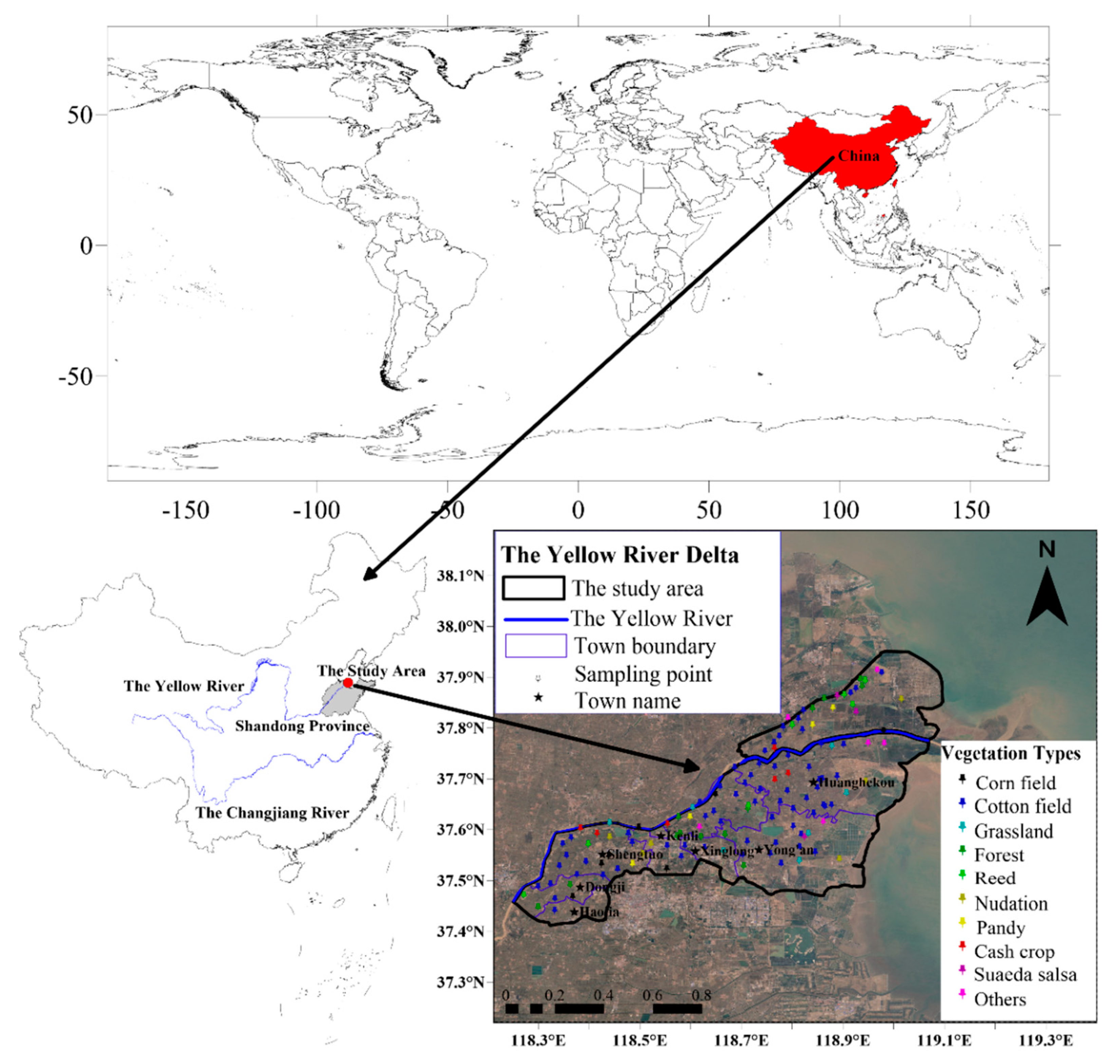
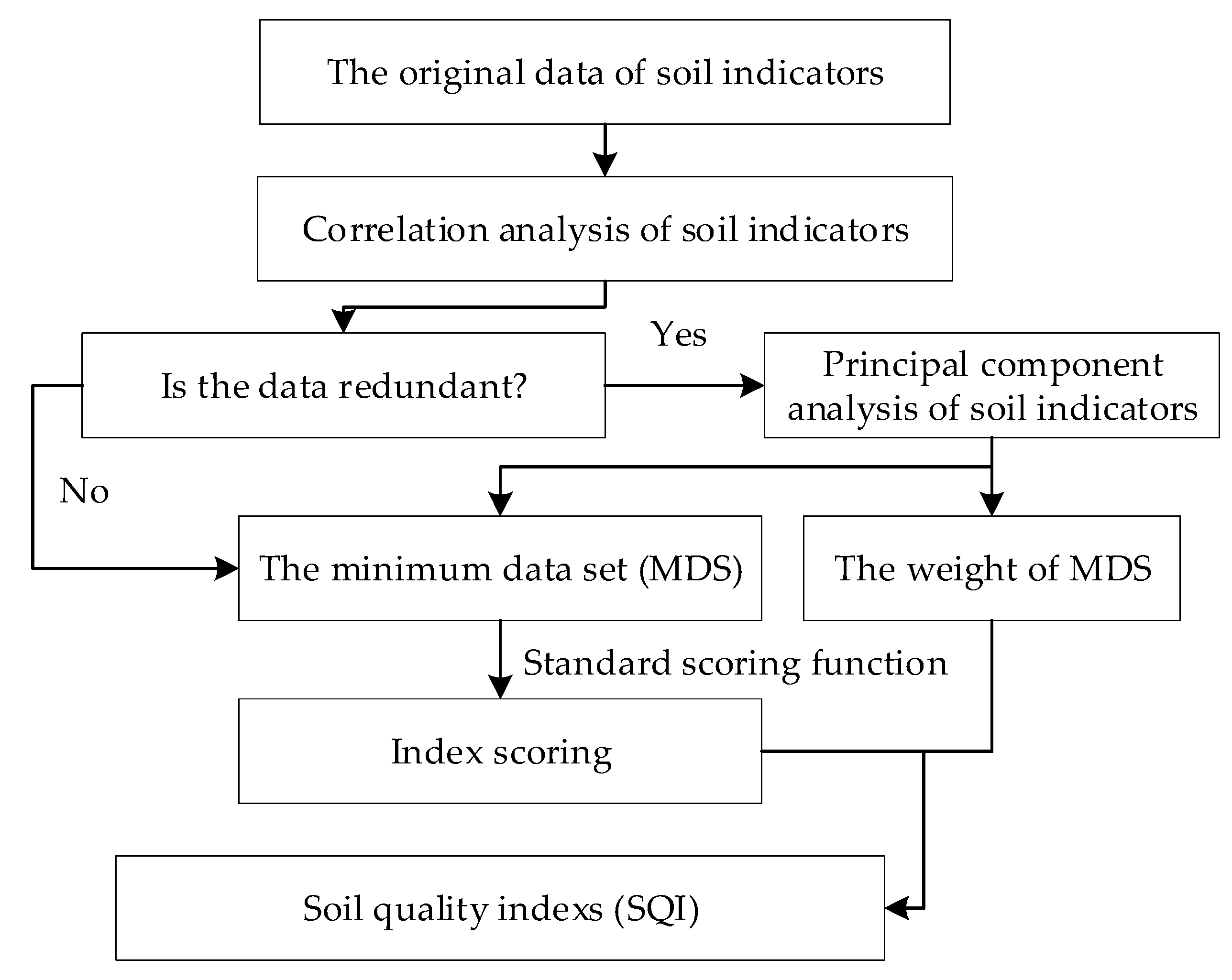
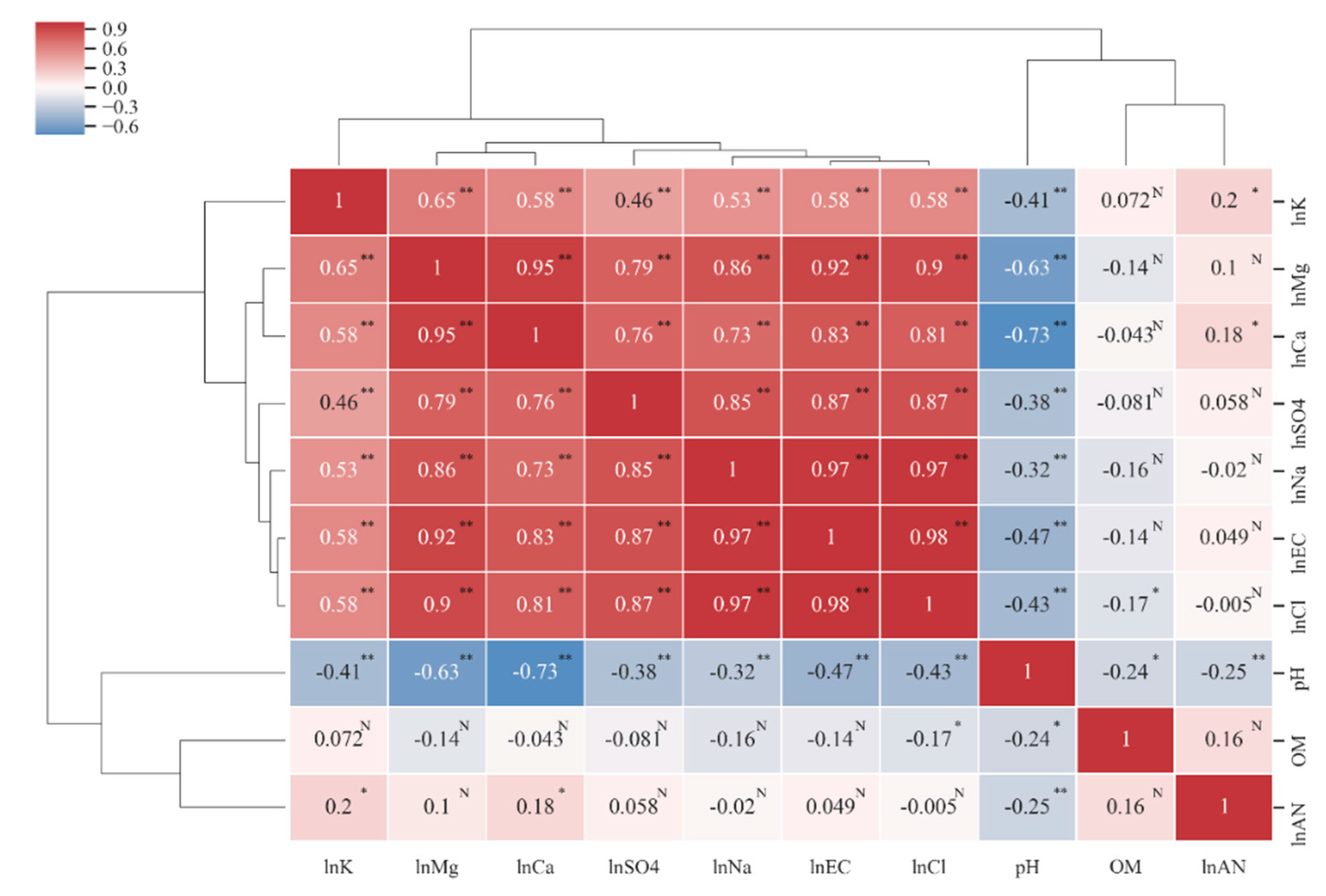
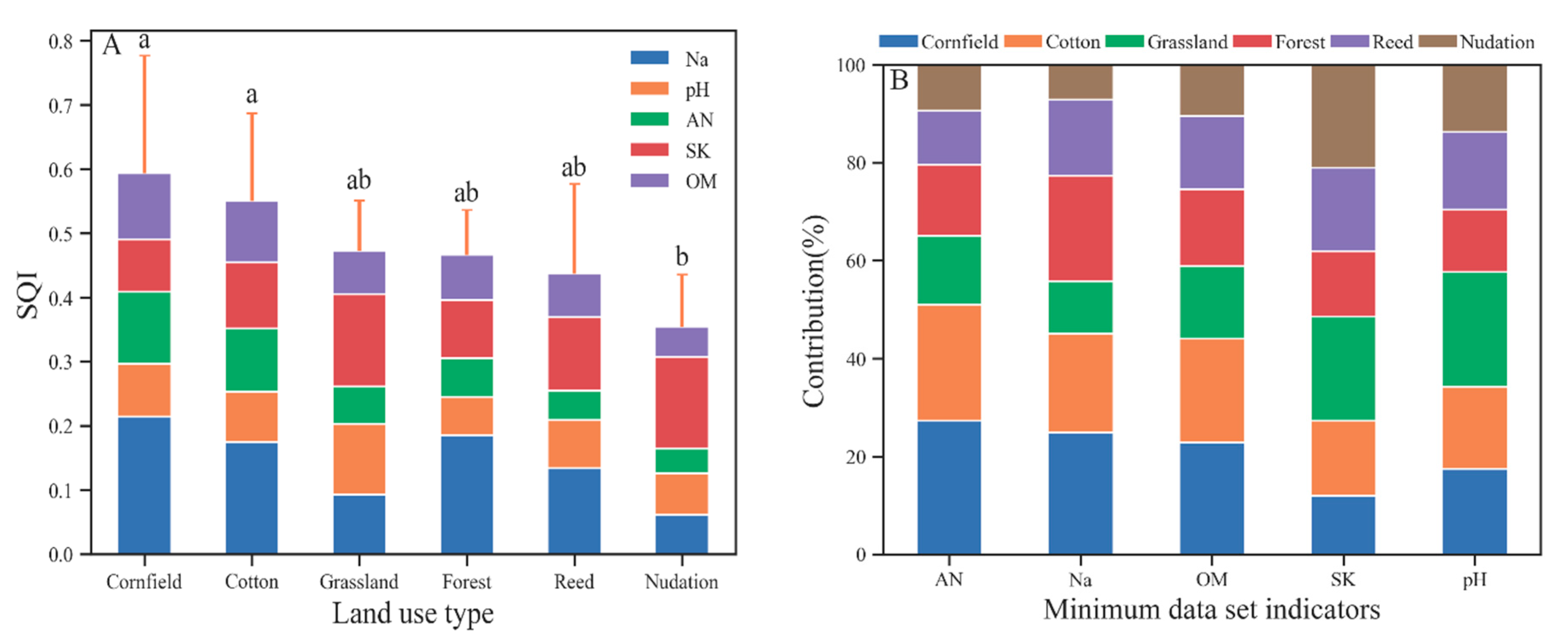
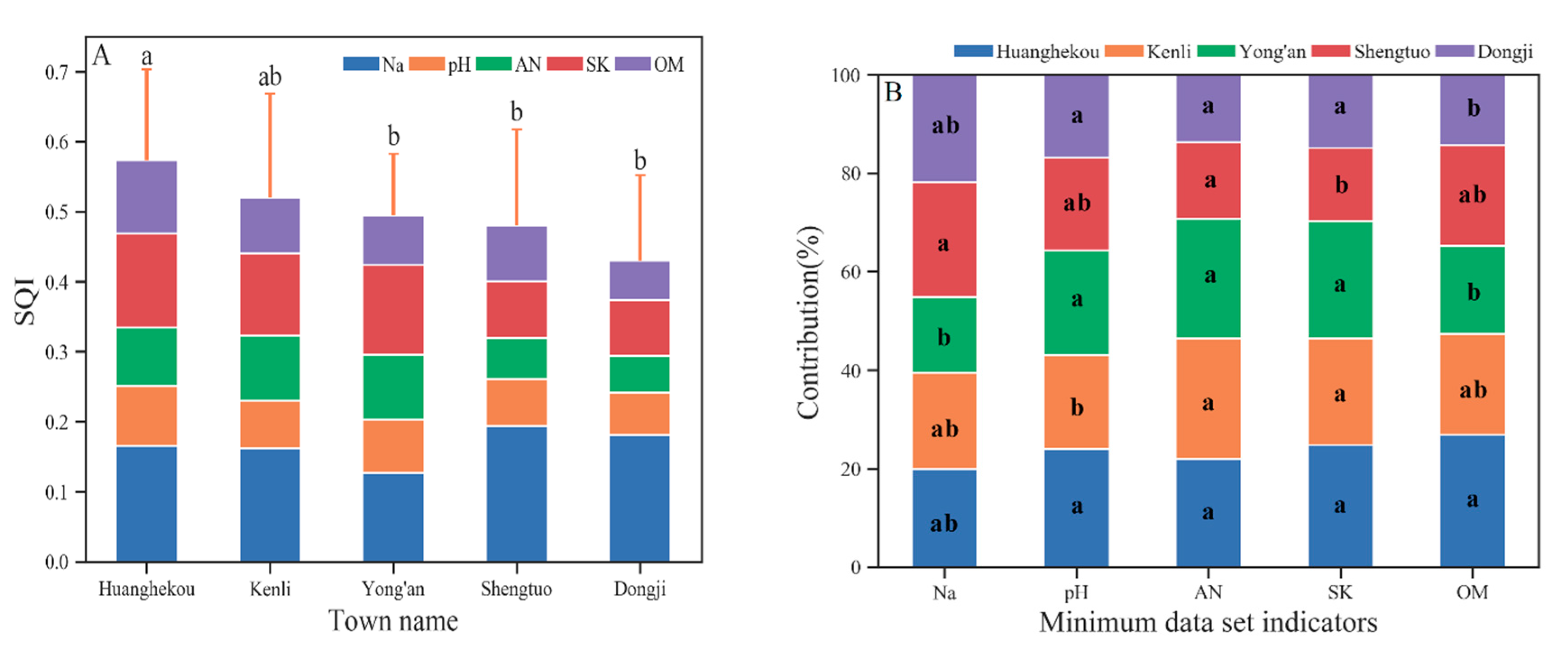
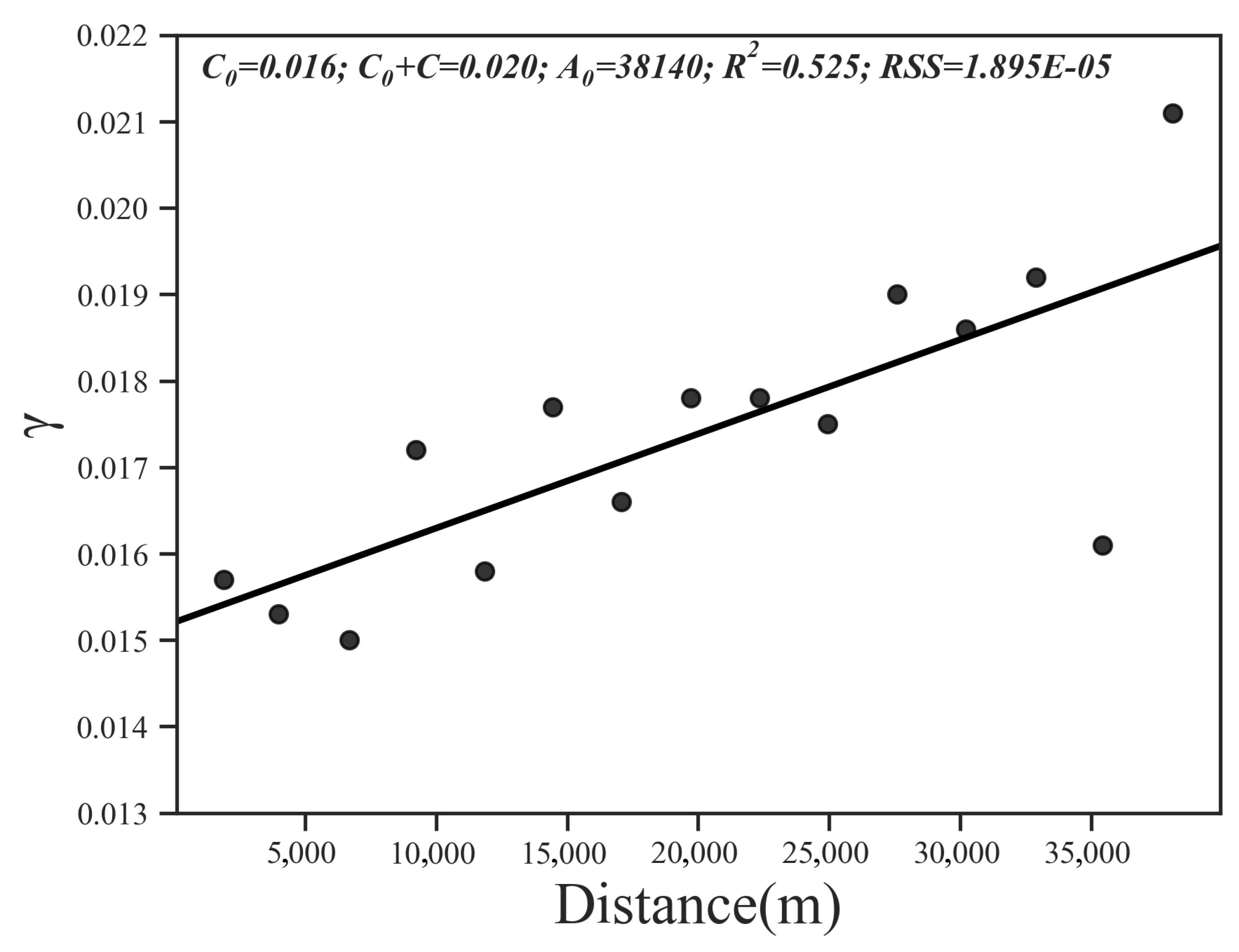
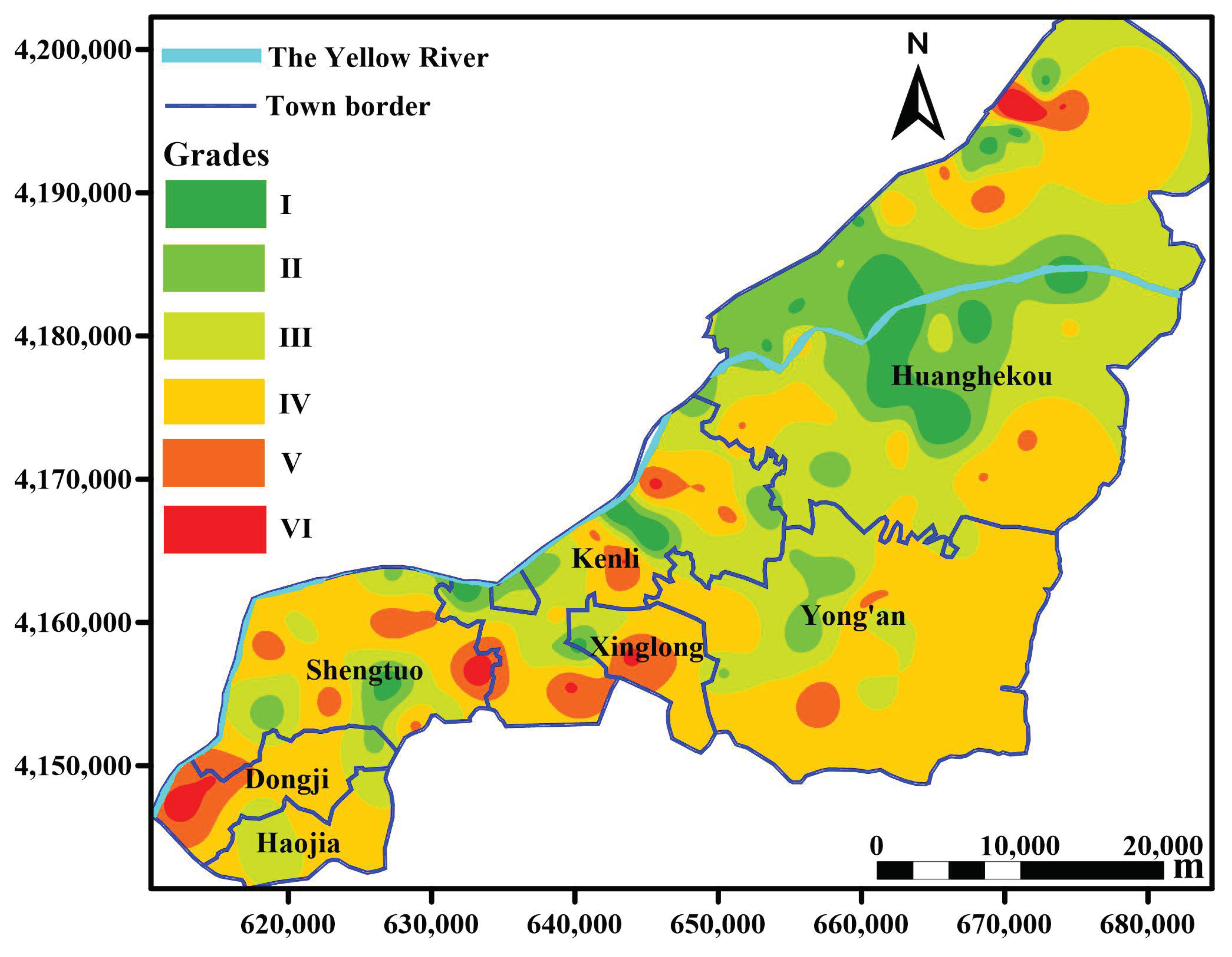
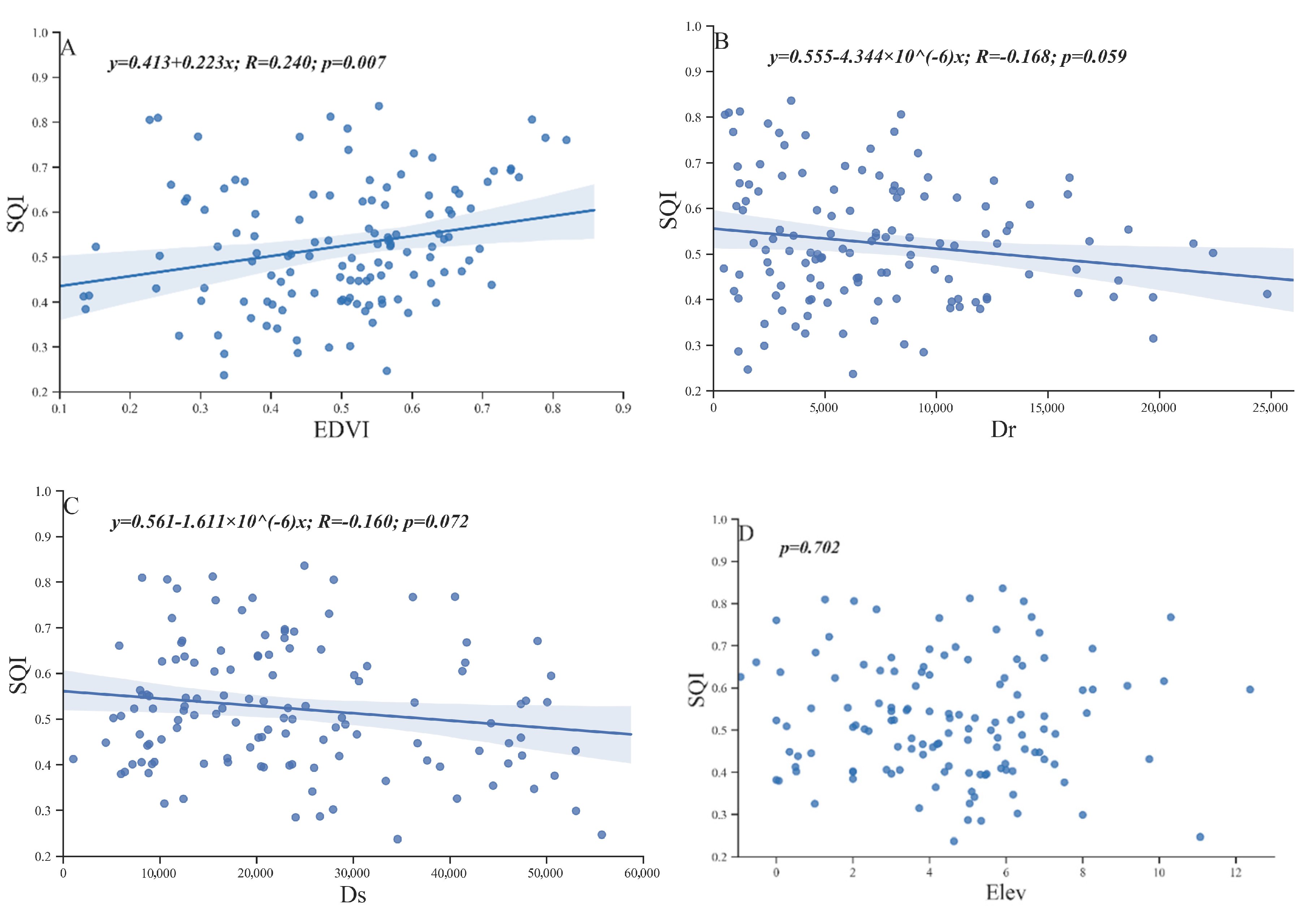
| Vegetation Types | Huanghekou | Yong’an | Kenli | Xinglong | Shengtuo | Dongji | Haoji | Sum |
|---|---|---|---|---|---|---|---|---|
| Cash crop | 2 | 0 | 1 | 0 | 2 | 0 | 0 | 5 |
| Corn field | 1 | 0 | 3 | 0 | 2 | 0 | 1 | 7 |
| Cotton field | 26 | 13 | 13 | 1 | 7 | 5 | 1 | 66 |
| Forest | 5 | 2 | 4 | 1 | 0 | 2 | 0 | 14 |
| Grass | 2 | 1 | 1 | 1 | 1 | 0 | 0 | 6 |
| Nudation | 2 | 1 | 1 | 0 | 2 | 0 | 0 | 6 |
| Others | 5 | 3 | 1 | 0 | 1 | 0 | 0 | 10 |
| Paddy land | 2 | 0 | 1 | 0 | 1 | 0 | 0 | 4 |
| Reed | 4 | 0 | 1 | 0 | 1 | 1 | 0 | 7 |
| Suaeda salsa | 2 | 0 | 0 | 0 | 0 | 0 | 0 | 2 |
| Sum | 51 | 20 | 26 | 3 | 17 | 8 | 2 | 127 |
| Variables | Mean | SE | Min | Q1 | Median | Q3 | Max |
|---|---|---|---|---|---|---|---|
| NDVI | 0.50 | 0.01 | 0.13 | 0.39 | 0.51 | 0.59 | 0.82 |
| Elev | 4.45 | 0.23 | −0.94 | 2.71 | 4.50 | 6.17 | 12.37 |
| Ds | 23,276 | 1201.46 | 1040 | 12,204 | 20,743 | 30,374 | 55,683 |
| Dr | 7360 | 468.48 | 464 | 3080 | 6418 | 10,547 | 24,817 |
| OM (g/kg) | 10.15 | 0.38 | 1.19 | 6.85 | 10.17 | 12.48 | 21.77 |
| pH | 8.50 | 0.02 | 7.91 | 8.35 | 8.49 | 8.65 | 9.31 |
| EC (mS/cm) | 0.74 | 0.19 | 0.08 | 0.28 | 0.66 | 1.65 | 10.26 |
| AN (mg/kg) | 56.59 | 8.14 | 9.83 | 33.97 | 49.30 | 90.45 | 503.13 |
| Cl (mg/kg) | 462.76 | 359.57 | 18.76 | 79.76 | 520.97 | 1866.50 | 20,303.66 |
| SO4 (mg/kg) | 328.89 | 55.23 | 32.47 | 167.62 | 345.98 | 709.29 | 5634.49 |
| Na (mg/kg) | 339.35 | 153.57 | 20.51 | 104.30 | 359.18 | 1017.57 | 9378.79 |
| Mg (mg/kg) | 43.66 | 24.74 | 4.13 | 14.13 | 28.03 | 105.12 | 1746.39 |
| Ca (mg/kg) | 157.14 | 35.97 | 26.19 | 78.92 | 145.07 | 281.40 | 3237.80 |
| SK (mg/kg) | 15.99 | 3.68 | 2.55 | 9.53 | 15.48 | 22.43 | 258.96 |
| PCs | PC1 | PC2 | PC3 |
|---|---|---|---|
| Eigenvalue | 5.595 | 1.379 | 1.048 |
| Percent | 55.947 | 13.794 | 10.485 |
| Cumulative percent | 55.947 | 69.741 | 80.226 |
| Eigenvectors | |||
| Cl | 0.966 | −0.144 | 0.036 |
| SO4 | 0.817 | 0.013 | −0.140 |
| Na | 0.909 | −0.194 | 0.132 |
| Mg | 0.969 | −0.053 | −0.104 |
| Ca | 0.867 | 0.107 | −0.261 |
| EC 1:5 | 0.970 | −0.103 | 0.028 |
| pH | −0.495 | −0.611 | 0.288 |
| AN | 0.055 | 0.661 | 0.560 |
| SK | 0.529 | 0.167 | 0.637 |
| OM | −0.095 | 0.677 | −0.358 |
| Indicators | NDVI | Elev | Ds | Dr | OM | pH | lnEC | lnAN | lnCl | lnSO4 | lnNa | lnMg | lnCa | lnK |
|---|---|---|---|---|---|---|---|---|---|---|---|---|---|---|
| NDVI | 1 | 0.01 | −0.08 | −0.11 | 0.15 | 0.03 | −0.21 * | 0.14 | −0.20 * | −0.09 | −0.22 * | −0.15 | −0.06 | −0.21 * |
| Elev | 0.01 | 1 | 0.75 ** | −0.36 ** | −0.14 | 0.17 | −0.26 ** | 0.03 | −0.30 ** | −0.21 * | −0.31 ** | −0.29 ** | −0.24 ** | −0.30 ** |
| Ds | −0.08 | 0.75 ** | 1 | −0.36 ** | −0.14 | 0.24 ** | −0.22 * | −0.11 | −0.24 ** | −0.16 | −0.24 ** | −0.32 ** | −0.28 ** | −0.42 ** |
| Dr | −0.11 | −0.36 ** | −0.36 ** | 1 | −0.05 | −0.24 ** | 0.26 ** | −0.08 | 0.27 ** | 0.16 | 0.26 ** | 0.31 ** | 0.27 ** | 0.25 ** |
| Group | Indicator | Norm | R2 | Normal Transformation | Value | Included | |||||||
|---|---|---|---|---|---|---|---|---|---|---|---|---|---|
| NDVI | Elev | Ds | Dr | Norm | NDVI | Elev | Ds | Dr | |||||
| 1 | EC1:5 | 2.31 | 0.08 | 0.10 | 0.10 | 0.13 | 1.00 | 0.72 | 0.91 | 0.87 | 0.83 | 4.33 | No |
| 1 | Cl | 2.30 | 0.09 | 0.10 | 0.11 | 0.15 | 1.00 | 0.84 | 0.97 | 1.00 | 0.96 | 4.77 | No |
| 1 | SO4 | 1.93 | 0 | 0.03 | 0 | 0 | 0.84 | 0 | 0.27 | 0 | 0 | 1.11 | No |
| 1 | Na | 2.18 | 0.11 | 0.11 | 0.11 | 0.15 | 0.94 | 1.00 | 1.00 | 0.97 | 1.00 | 4.91 | Yes |
| 1 | Mg | 2.30 | 0 | 0.08 | 0.10 | 0.11 | 1.00 | 0 | 0.71 | 0.90 | 0.69 | 3.29 | No |
| 1 | Ca | 2.08 | 0 | 0.04 | 0.05 | 0.05 | 0.90 | 0 | 0.39 | 0.48 | 0.35 | 2.12 | No |
| 2 | OM | 0.92 | 0 | 0 | 0 | 0 | 0.40 | 0 | 0 | 0 | 0 | 0.40 | Yes |
| 3 | pH | 1.43 | 0 | 0 | 0.06 | 0.06 | 0.62 | 0 | 0 | 0.52 | 0.38 | 1.14 | Yes |
| 4 | AN | 0.99 | 0 | 0 | 0 | 0 | 0.43 | 0 | 0 | 0 | 0 | 0.43 | Yes |
| 5 | SK | 1.43 | 0.08 | 0.03 | 0.07 | 0.05 | 0.62 | 0.69 | 0.31 | 0.62 | 0.33 | 2.24 | Yes |
| Indicator | SSF | Value | Weight |
|---|---|---|---|
| Na | SSF3 | 0.881 | 0.241 |
| pH | SSF3 | 0.690 | 0.189 |
| OM | SSF1 | 0.623 | 0.170 |
| AN | SSF1 | 0.772 | 0.211 |
| SK | SSF1 | 0.691 | 0.189 |
| Land Use | Points | Means | CV | I (>0.7) | II (0.6–0.7) | III (0.5–0.6) | IV (0.4–0.5) | V (0.3–0.4) | VI (<0.3) | ||||||
|---|---|---|---|---|---|---|---|---|---|---|---|---|---|---|---|
| Total | 127 | 0.52 ± 0.14 | 0.26 | 13 | 10.2% | 25 | 19.7% | 30 | 23.6% | 37 | 29.1% | 17 | 13.4% | 5 | 3.9% |
| Cornfield | 7 | 0.60 ± 0.2 a | 0.33 | 3 | 42.9% | 1 | 14.3% | 0 | 0.0% | 2 | 28.6% | 0 | 0.0% | 1 | 14.3% |
| Cotton | 67 | 0.55 ± 0.14 a | 0.26 | 9 | 13.4% | 18 | 26.9% | 17 | 25.4% | 12 | 17.9% | 9 | 13.4% | 2 | 3.0% |
| Grassland | 7 | 0.47 ± 0.08 ab | 0.17 | 0 | 0.0% | 1 | 14.3% | 2 | 28.6% | 3 | 42.9% | 1 | 14.3% | 0 | 0.0% |
| Forest | 14 | 0.48 ± 0.07 ab | 0.15 | 0 | 0.0% | 1 | 7.1% | 4 | 28.6% | 8 | 57.1% | 1 | 7.1% | 0 | 0.0% |
| Reed | 7 | 0.45 ± 0.14 ab | 0.31 | 0 | 0.0% | 1 | 14.3% | 1 | 14.3% | 2 | 28.6% | 2 | 28.6% | 1 | 14.3% |
| Nudation | 6 | 0.36 ± 0.07 b | 0.20 | 0 | 0.0% | 0 | 0.0% | 0 | 0.0% | 2 | 33.3% | 3 | 50.0% | 1 | 16.7% |
Publisher’s Note: MDPI stays neutral with regard to jurisdictional claims in published maps and institutional affiliations. |
© 2020 by the authors. Licensee MDPI, Basel, Switzerland. This article is an open access article distributed under the terms and conditions of the Creative Commons Attribution (CC BY) license (http://creativecommons.org/licenses/by/4.0/).
Share and Cite
Jiang, M.; Xu, L.; Chen, X.; Zhu, H.; Fan, H. Soil Quality Assessment Based on a Minimum Data Set: A Case Study of a County in the Typical River Delta Wetlands. Sustainability 2020, 12, 9033. https://doi.org/10.3390/su12219033
Jiang M, Xu L, Chen X, Zhu H, Fan H. Soil Quality Assessment Based on a Minimum Data Set: A Case Study of a County in the Typical River Delta Wetlands. Sustainability. 2020; 12(21):9033. https://doi.org/10.3390/su12219033
Chicago/Turabian StyleJiang, Mingliang, Ligang Xu, Xiaobing Chen, Hua Zhu, and Hongxiang Fan. 2020. "Soil Quality Assessment Based on a Minimum Data Set: A Case Study of a County in the Typical River Delta Wetlands" Sustainability 12, no. 21: 9033. https://doi.org/10.3390/su12219033
APA StyleJiang, M., Xu, L., Chen, X., Zhu, H., & Fan, H. (2020). Soil Quality Assessment Based on a Minimum Data Set: A Case Study of a County in the Typical River Delta Wetlands. Sustainability, 12(21), 9033. https://doi.org/10.3390/su12219033






